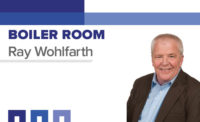For a sales transaction to be successful, certain expectations are required for both the buyer and the seller. That same type of arrangement holds true when a building owner purchases a boiler. The owner expects to have a heating system that is trouble-free, efficient and will last for decades. The designer, installer and manufacturer expect to be paid in a timely manner for their design, equipment and installation.
But there is a further expectation of the owner that is rarely mentioned. The designer, manufacturer and installer expect the owner to maintain the new equipment. When it does not happen, bad things can and will occur.
The following are some projects that went south because the equipment was not maintained properly. This may help you on your next boiler project.
• Two-pipe system.
The original installer called to tell me the boilers we sold a building owner several years ago were a mess and the owner wanted the installer to replace the boilers for free.
Upon arrival, I found the installer was telling the truth. The tubes were filled with rust, the insulation had black mold and the boiler jacket had rust streaks. The system was a two-pipe system, which used either hot or chilled water. The owner never isolated the boilers during the cooling season and chilled water flowed through the boilers for the past four years. The boilers were ruined.
• Low water cut-off.
The text from my friend asked that I call him right away, saying it was important. When I called, he told me the two-year-old, cast-iron steam boiler he installed had suffered a major failure. The boiler dry-fired and was ruined.
The cause of the failure was the owner never blew down or even checked the low-water cut-offs. The interior of the low-water cut-offs were filled with mud, holding the internal float in place, fooling the boiler into thinking it was full of water. The low-water cut-off is the leading mechanical cause for boiler failures. Luckily, the system did not explode and there were no injuries, but the boiler was ruined.
• Thermal shock.
The maintenance director of a university informed me its cast-iron sectional boiler kept cracking sections and he was blaming the boiler manufacturer.
I found the boiler was only about two-thirds the original size, as the owner kept removing the damaged sections and shortening the boiler. The owner also never changed the firing rate of the burner so it was grossly oversized for the now-shortened boiler. In addition, the blend pump which was supposed to help to avoid the thermal shock the boiler was experiencing was inoperable.
• Water temperature issues.
“One of the new boilers is leaking” was the call I received on a Monday morning. The “new boiler” was actually six years old. I saw excessive rust on the fireside of the boiler. I checked the control set points and was amazed the damage was not worse. The boiler operating control was set for 140° F and the reset control was set down to 90°. The loop temperature on that day was 110°.
I asked how the controls got so far out. He shrugged his shoulders and asked if it was covered under warranty. It was not. If a standard boiler is operated below 140°, the flue gases will condense and acids will eat away the fireside of the boiler.
• pH levels.
The four-year-old boiler had a pinhole in the top of the casting. When I checked the pH in the water, it was at 12. The boiler manufacturer stipulates that the pH should be between 6.5 and 8.5. Although the 3.5 difference between the actual reading and highest level seems insignificant, it is actually very large. PH readings are logarithmic, which means that a difference of one means the difference is really 10 times as much. A difference of two means the difference is 100 times.
The 3.5 difference means the actual pH reading was 5,000 times more caustic than the manufacturer stipulates. When the water is caustic, it could cause scale buildup and even caustic embrittlement, which will destroy the boiler. In addition, the water treatment company did not realize the boiler was an aluminum boiler, which would require a different type of water treatment.
• Oversized equipment.
We were in the boiler room to service a leaking circulator pump when I walked behind the boiler looking for isolation valves and saw the condition of the flue. It was peppered with small holes and rust trails. It also had small piles of rust under the draft diverter. The boiler was so oversized that the chimney never had a chance to warm the flue. It would short-cycle and flue gases would condense. The flue had to be replaced.
Maintenance is key
Boiler maintenance, or lack thereof, is the leading cause of boiler failures. In my area, there are roughly 4,000 heating hours per year. If you equate that to an automobile and that vehicle drives those same 4,000 hours at an average speed of 25 miles per hour, the vehicle would have 100,000 miles the first year and 200,000 miles by year two. Could you imagine driving a car for that many miles without doing any maintenance?
Lack of boiler maintenance has been a common issue and leads to shortened equipment life and dangerous conditions. As a matter of fact, the ASME CSD1 CM-110 code recognizes the problem and stipulates the following:
“… a systematic and thorough maintenance program shall be established and performed.”
“… results shall be recorded in a boiler log, maintenance record, service invoice or other written record.”
“Any defects found shall be brought to the attention of the boiler owner and shall be corrected immediately.”
“CM-120. The qualified individual performing inspections and tests shall be trained and familiar with all operating procedures …”
A few things should be done to make sure a boiler has a long life:
1. Perform regular maintenance on the boiler.
2. Do not operate the boiler outside of its design parameters.
3. Have the boiler regularly inspected.
I realize many facilities do not have a maintenance budget or individuals who can service boilers. The irony is they do not have the money for maintenance but somehow find the funds to prematurely replace the equipment. Perhaps it is time for engineers and installers to offer an extended maintenance agreement with the new equipment or maintenance organizations need to show building owners the ASME CSD1 code and adhere to it.





